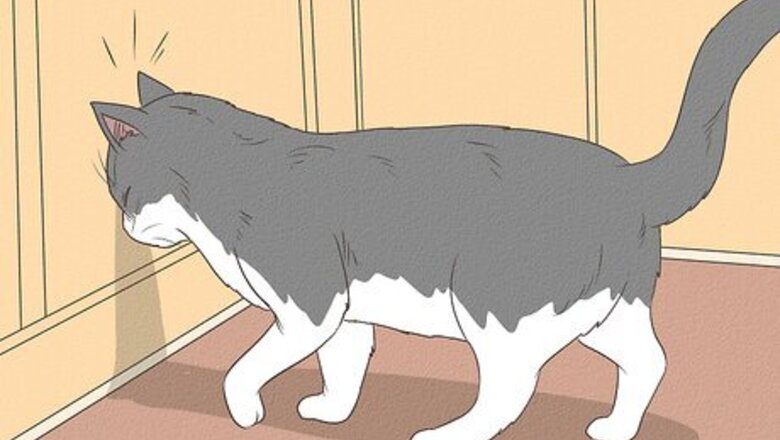
views
Looking for Behavioral Changes
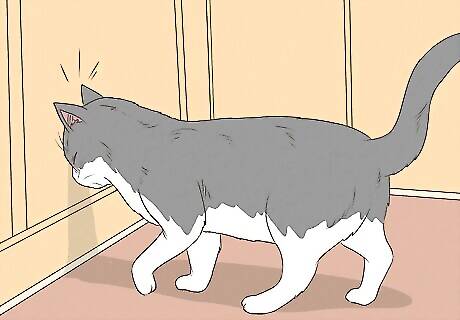
Look out for clumsiness. Watch to see how your cat gets around furniture or if it misjudges jumping onto furniture. Also note if your cat bumps into walls or furniture that it previously knew to walk around. Acting clumsy in spaces where it spends a lot of time can be a sign of failing sight or blindness. Another sign to watch for is if your cat is tripping on stairs or slipping when trying to jump up to its favorite place. Note if your cat is having problems with other familiar objects, like finding its food and water bowls.
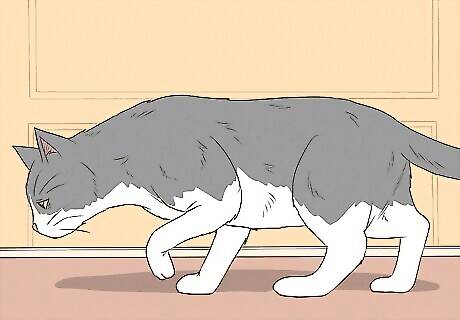
Watch your cat’s walk. Pay attention to your cat’s walk. Note if it is crouching closer to the ground. It may be feeling its way with its nose and whiskers. Other signs to watch are if your cat is walking with its head down or is moving its head up and down to figure out distances. Another sign to look for is if your cat is wandering aimlessly.

Listen to your cat. Do you hear your cat vocalizing more? When cats do not see well or are blind, they tend to be noisier to vocalize their distress. You may also notice that your cat is generally acting nervous, fearful, or upset as it adjusts to its lack of sight. You may also see that your cat is more easily startled.
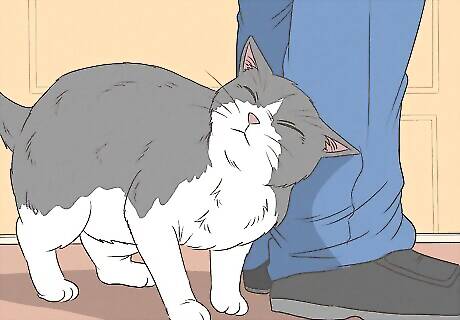
Notice if your cat is clingy. Look for signs that your cat is less confident than usual. For example, note if your cat clings to you more or spends more time by your side. Also pay attention to if your cat sleeps more or generally moves around less often than usual.
Noting Changes to the Eyes

Look at your cat’s pupils. If you suspect your cat is blind or going blind, look at its pupils. Note if the pupils stay the same in both bright and low light. Also check to see if the pupils are different sizes. Both of these are signs of blindness or incipient blindness. Also note if your cat is squinting or if it’s indifferent to changes in lighting.
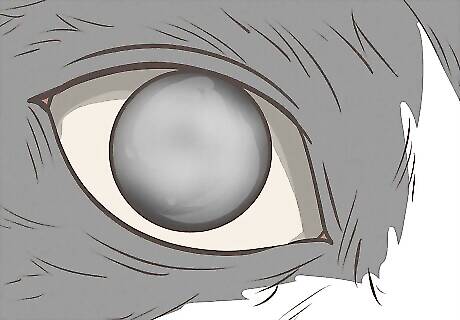
Check out the color of your cat’s eyes. One of the changes you may see is a change of eye color. Additionally, look for more redness in your cat’s eyes. Alternatively, you might see that your cat’s eyes look milkier, cloudier, or appear more white. Look for excessive redness in the tissues around the eyes. Don’t worry if this is lighter pink, which is normal. If the lenses of your cat’s eyes are opaque, this might be a sign of cataracts.
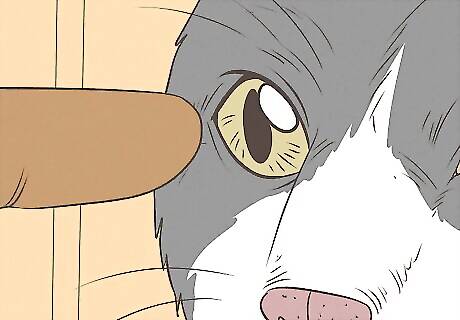
Test your cat’s menace reflex. Move a fingertip quickly towards your cat’s eye without making contact with the cornea. A sighted cat will flinch or blink when you move your fingertip towards them, but a blind cat will remain unaware of your finger. Don’t get too close to your cat’s whiskers or create a breeze on its whiskers so it can't sense your finger approaching its face.
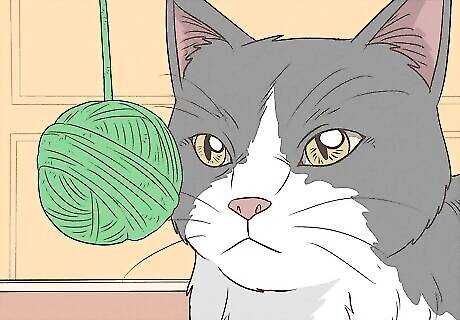
Try dropping a ball of yarn in front of your cat. Notice if she watches or follows the descent of the ball. Most sighted cats will watch the ball drop. A blind cat will remain oblivious as the ball passes in front of it. Avoid getting too close to your cat's whiskers so it doesn't sense the ball.
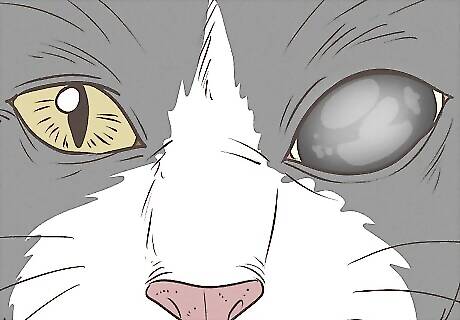
Pay attention to the eyes’ size to check for glaucoma. If one eye seems larger than another, take your cat to the vet. This may be a sign of glaucoma. While this does not necessarily mean that your cat is blind, glaucoma can cause blindness if left untreated. One or both eyes may also appear cloudy.
Caring for Your Blind Cat
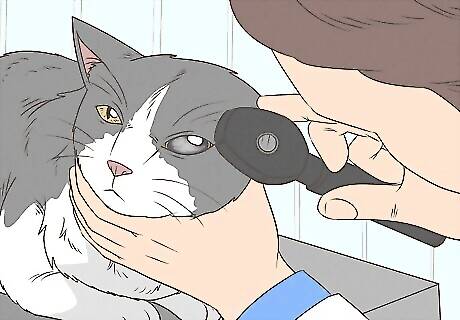
Take your cat to the vet. Bring your cat to the vet if you suspect it is blind or may be going blind. Share your concerns with the vet, including a list of the symptoms that you’ve noticed. Take your cat to the vet as soon as you can because early treatment can be critical in preventing overall blindness or catching a dangerous condition that may have led to the symptoms you’ve observed. Blindness can be a symptom of other serious diseases, such as high blood pressure. High blood pressure can cause strokes and seizures, so it is important to treat it early. Confirm suspected blindness in a rescue cat. "I rescued a 6-month-old stray kitten who seemed blind — he was hesitant to move and clung to me constantly. The article confirmed my suspicion when it said blindness causes clinginess and limited activity. My vet missed this, but now I can get my kitten treatment thanks to recognizing the signs of blindness described here." - Laine F. Evaluate changes in vocalization. "My cat had been meowing a lot more than usual early in the morning. When I noticed his pupils were different sizes, I wondered if he was going blind. The article said increased vocalizing can indicate distress from vision issues. I'm hoping the vet tomorrow can help, but this gave me a good idea of what might be happening with the changes I'd observed." - Julia C. Educate a family member about signs. "When I told my son I thought our cat might be going blind, he found this article. It helped him recognize the validity of my assumption based on the tips provided. I appreciate having a resource to educate family members about identifying blindness in cats." - Connie R. Understand causes beyond blindness. "At 16, my cat's vet said he was going blind. She tested and treated his blood pressure, but his vision issues persisted. This article explained blindness can result from other problems like high blood pressure. Though his pressure stabilized, it helped me understand the cause might be bigger than blindness alone." - Hope D. We want to hear from you! Advice from our readers makes our articles better. If you have a story you’d like to share, tell us here.

Keep things consistent at home. Make as few changes as you can to your cat’s environment. This will help it adjust to its lack of sight. Avoid moving food and water dishes and litter boxes so your cat can easily find them. You can also lower the furniture or provide ramps for it to more easily climb onto furniture. Keep your floors clutter-free to help your cat move around more easily.
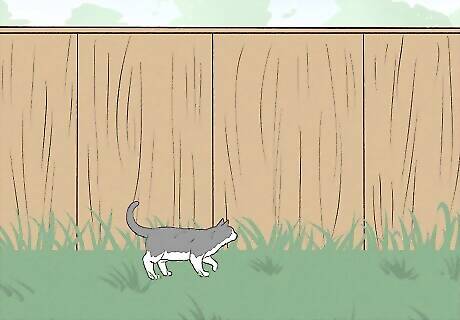
Supervise your cat outdoors. Escort your cat if you take it outdoors and make sure to keep it in an enclosed area. Otherwise, keep your cat inside to protect it. Keep windows and doors closed to keep it indoors. Similarly, board up any pet doors.

Get your cat identification. Microchip your cat in case it leaves home. Also make sure your cat has a collar and tags. Add a tag that notes your cat is blind or has limited sight.

Avoid startling your cat. Try not to make loud noises or startle your cat. Do your best to stay calm around it and to keep it calm. Also warn family members, especially children, and visitors not to make loud noises or do anything that can scare your cat. When you walk into a room, say something out loud so your cat knows you're coming.




















Comments
0 comment